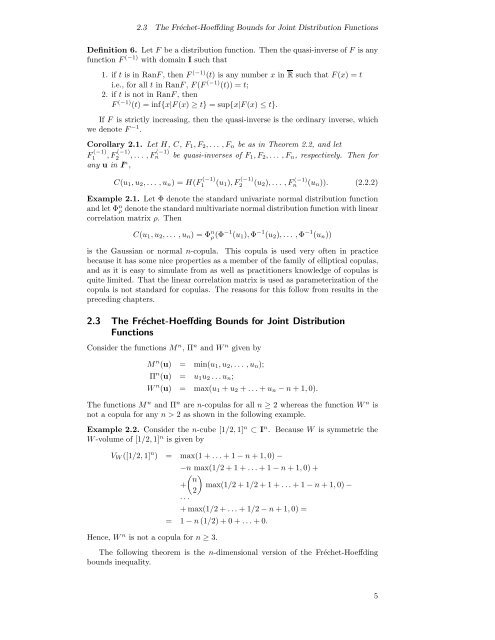Modelling Dependence with Copulas - IFOR
Modelling Dependence with Copulas - IFOR
Modelling Dependence with Copulas - IFOR
Create successful ePaper yourself
Turn your PDF publications into a flip-book with our unique Google optimized e-Paper software.
2.3 The Fréchet-Hoeffding Bounds for Joint Distribution Functions<br />
Definition 6. Let F be a distribution function. Then the quasi-inverse of F is any<br />
function F (−1) <strong>with</strong> domain I such that<br />
1. if t is in RanF ,thenF (−1) (t) is any number x in R such that F (x) =t<br />
i.e., for all t in RanF , F (F (−1) (t)) = t;<br />
2. if t is not in RanF ,then<br />
F (−1) (t) = inf{x|F (x) ≥ t} =sup{x|F (x) ≤ t}.<br />
If F is strictly increasing, then the quasi-inverse is the ordinary inverse, which<br />
we denote F −1 .<br />
Corollary 2.1. Let H, C, F 1 ,F 2 ,... ,F n be as in Theorem 2.2, and let<br />
F (−1)<br />
1 ,F (−1)<br />
2 ,... ,F n<br />
(−1) be quasi-inverses of F 1 ,F 2 ,... ,F n , respectively. Then for<br />
any u in I n ,<br />
C(u 1 ,u 2 ,... ,u n )=H(F (−1)<br />
1 (u 1 ),F (−1)<br />
2 (u 2 ),... ,F n (−1) (u n )). (2.2.2)<br />
Example 2.1. Let Φ denote the standard univariate normal distribution function<br />
and let Φ n ρ denote the standard multivariate normal distribution function <strong>with</strong> linear<br />
correlation matrix ρ. Then<br />
C(u 1 ,u 2 ,... ,u n )=Φ n ρ (Φ−1 (u 1 ), Φ −1 (u 2 ),... ,Φ −1 (u n ))<br />
is the Gaussian or normal n-copula. This copula is used very often in practice<br />
because it has some nice properties as a member of the family of elliptical copulas,<br />
and as it is easy to simulate from as well as practitioners knowledge of copulas is<br />
quite limited. That the linear correlation matrix is used as parameterization of the<br />
copula is not standard for copulas. The reasons for this follow from results in the<br />
preceding chapters.<br />
2.3 The Fréchet-Hoeffding Bounds for Joint Distribution<br />
Functions<br />
Consider the functions M n ,Π n and W n given by<br />
M n (u) = min(u 1 ,u 2 ,... ,u n );<br />
Π n (u) = u 1 u 2 ...u n ;<br />
W n (u) = max(u 1 + u 2 + ...+ u n − n +1, 0).<br />
The functions M n and Π n are n-copulas for all n ≥ 2 whereas the function W n is<br />
not a copula for any n>2 as shown in the following example.<br />
Example 2.2. Consider the n-cube [1/2, 1] n ⊂ I n . Because W is symmetric the<br />
W -volume of [1/2, 1] n is given by<br />
V W ([1/2, 1] n ) = max(1+...+1− n +1, 0) −<br />
−n max(1/2+1+...+1− n +1, 0) +<br />
( n<br />
+ max(1/2+1/2+1+...+1− n +1, 0) −<br />
2)<br />
...<br />
+max(1/2+...+1/2 − n +1, 0) =<br />
= 1− n (1/2) + 0 + ...+0.<br />
Hence, W n is not a copula for n ≥ 3.<br />
The following theorem is the n-dimensional version of the Fréchet-Hoeffding<br />
bounds inequality.<br />
5
















